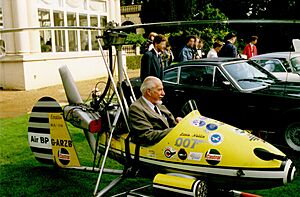Ken Wallis facts for kids
Wing Commander Kenneth Horatio Wallis (26 April 1916 – 1 September 2013) was a British aviator, engineer, and inventor. He was known for his amazing flying skills and for designing special aircraft called autogyros. During World War II, Wallis was a pilot in the Royal Air Force, flying many dangerous missions. After the war, he worked on new inventions and designs. He became famous for his autogyros, setting 34 world records. At the time of his death in 2013, he still held eight of these records.
Quick facts for kids
Kenneth Horatio Wallis
MBE, DEng(hc), PhD(hc), CEng, FRAeS, FSETP FInstTA(hc), RAF (Ret'd)
|
|
|---|---|

Ken Wallis sitting in his autogyro Little Nellie
|
|
| Born | 26 April 1916 Ely, Cambridgeshire, England |
| Died | 1 September 2013 (aged 97) Dereham, Norfolk, England |
| Allegiance | |
| Service/ |
|
| Years of service | 1939–1964 |
| Rank | Wing Commander |
| Unit | No. 268 Squadron RAF No. 103 Squadron RAF No. 37 Squadron RAF |
| Battles/wars | World War II |
| Awards | Distinguished Service Order |
| Other work | Leading exponent of autogyros |
Contents
Early Life and Inventions
Kenneth Horatio Wallis was born on 26 April 1916 in Ely, Cambridgeshire. From a young age, he loved mechanics and building things. When he was just 11 years old, he built his own motorcycle!
In 1936, Wallis was inspired by a flying machine called the "Flying Flea." He started to build his own, using only a book as a guide. However, he stopped building it because there were many accidents with that type of aircraft.
Wallis also enjoyed powerboats. He raced them until 1957, when he won a long race called the Missouri Marathon.
Military Service in the RAF
Wallis tried to join the Royal Air Force (RAF) several times. At first, he was turned away because of a problem with his right eye. But he was determined! He got a private flying licence, which had easier eye requirements.
In 1939, he tried again and finally passed the eye test. He later admitted he cleverly turned his head slightly to use his good eye during the test. He passed with "Above Average Eye Sight!"
Wallis's military career began with patrols in Westland Lysander planes. In 1942, he joined RAF Bomber Command. He flew Wellington bombers on 28 missions over Germany during World War II. Later, he served in Italy and flew the huge Convair B-36 bomber for the United States. After the war, he worked on research and development, inventing many things. Wallis left the RAF in 1964.
Amazing Autogyros
After leaving the RAF, Wallis became a leading expert in autogyros. These are aircraft that look a bit like helicopters but work differently. They have an unpowered rotor that spins freely as the aircraft moves forward.
Wallis designed and built his own autogyros for special uses like looking at areas from the air, research, and military tasks. He believed his designs needed to be built to very high standards for safety.
In 1962, Wallis worked with Beagle Aircraft to build five of his Wallis WA-116 autogyros. The British Army tested them, but they chose a different helicopter instead.
One of Wallis's most famous autogyros was named Little Nellie. He flew Little Nellie himself as a stunt pilot in the 1967 James Bond film You Only Live Twice.
From 2006 to 2009, Wallis was part of a documentary film called Into the Wind. In the film, released in 2012, he showed off several of his autogyro designs.
World Records and Recognition
Ken Wallis was a world record holder for many autogyro achievements. He was also recognized as the oldest pilot to set a world flight record, which he did at the age of 89!
He held most of the autogyro world records during his flying career. These included:
- Fastest time to climb to a certain height.
- A speed record of 189 km/h (111.7 mph).
- The longest straight-line distance record of 869.23 km (539.99 mi).
On 16 November 2002, he even increased his own speed record to 207.7 km/h (129.1 mph).
Wallis received the MBE (Member of the Order of the British Empire) award in 1996 for his achievements. In July 2013, he received a special medal for his 28 bomber missions during World War II.
Later Life and Legacy
Ken Wallis was married to Peggy Stapley, who also served in the Women's Auxiliary Air Force. They were married from 1942 until her death in 2003.
Wallis passed away on 1 September 2013, at the age of 97. Before he died, he lived in the village of Reymerston in Norfolk.
A special event was held at Old Buckenham Airport on 29 September 2013 to celebrate his life. Around 3,000 to 4,000 people attended, showing how much he was admired.
Images for kids
See also
- Little Nellie 007

